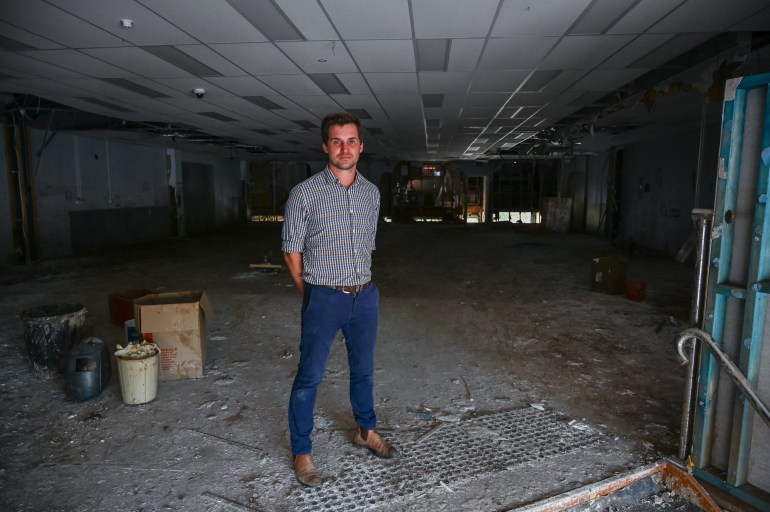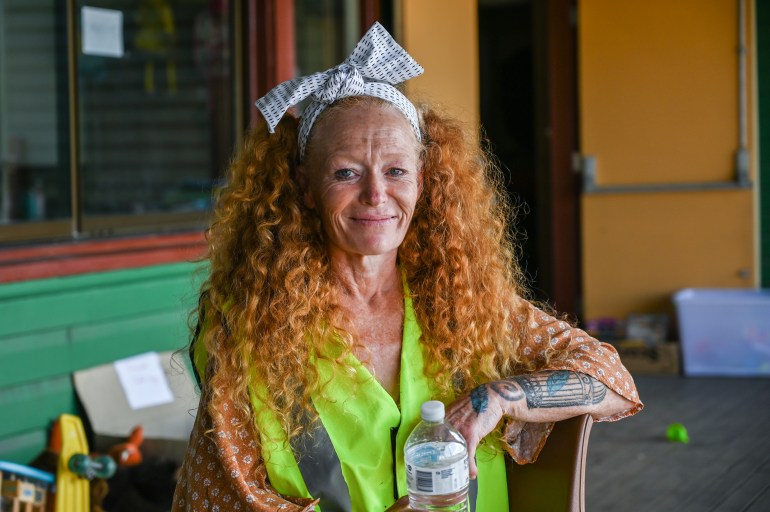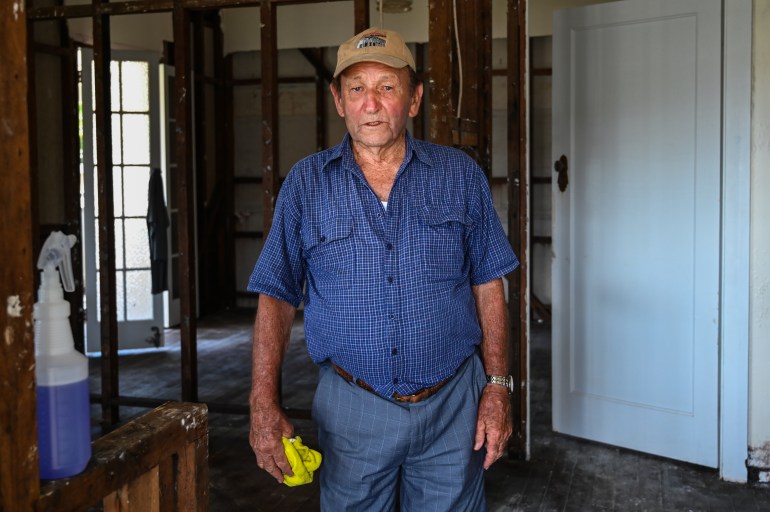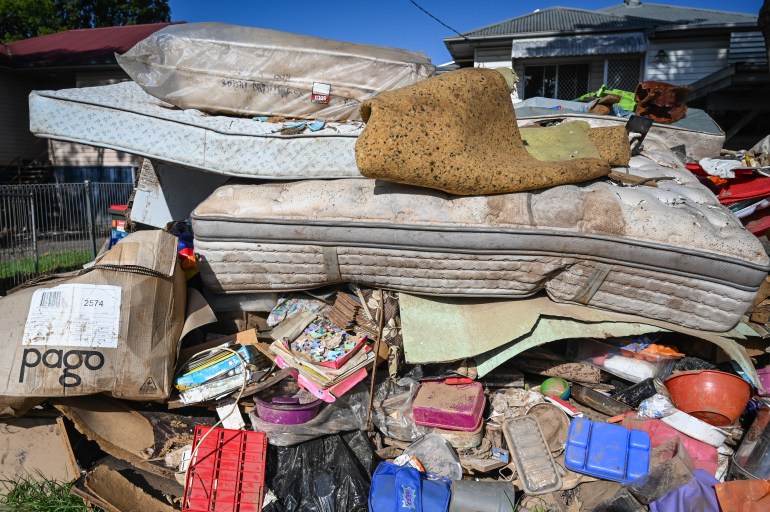‘The water just kept coming, and coming, and coming’
Lismore, Australia – In late February torrential rain hit the northern part of the Australian state of New South Wales submerging the region under raging floods.
Now – with residents still attempting to rebuild – the area’s been hit again, leaving many in despair.
“I think if they had their choice, they would just leave because a lot of them have literally just finished cleaning up their houses only to be flooded again,” Lismore chemist owner Kyle Wood told Al Jazeera.
“Everyone was still raw from the other one, and it’s not as if the town had [been] repaired… there’s still quite a few thousand condemned homes and people displaced everywhere.”
When the rain came last month, Wood thought his shop – which sits higher than the street above a small flight of stairs – would be safe.
But as the rain fell, Lismore and other towns across the Northern Rivers, the official name for the region, were inundated by water so deep that people had to climb onto their roofs.
By 3pm on February 28, the level of the Wilsons River, which runs through the heart of Lismore and is the area’s main tributary, was 14.37 metres (47 feet) – more than two metres above the previous record high in February 1954.
The water “went through and destroyed” Wood’s chemist, leaving everything but the top two levels of the dispensary a wet, stinking mess.

Some people managed to evacuate but many were stranded in their homes as the water rose.
MJ, a resident of Woodburn, a town about 34km (21 miles) south of Lismore, said that before the floodwaters swamped the town, people had moved their cars to her street because it was “one of the highest” in town.
“And then the water just kept coming, and coming, and coming,” she said.
MJ’s 89-year-old neighbour, Toby Bell, was rescued from his sister’s veranda a few doors down as the floods rose to the second storey.
He had waded across to her while he still could.
“All we could hear was cows and calves [going] down the river,” he said.
Like Bell, hundreds of people across the Northern Rivers were stranded in their homes.
In just 24 hours, the State Emergency Services (SES), a state government emergency and rescue service for natural and man-made disasters, received 927 calls for help from people in Lismore alone.


Nancy Grimm and Daniel Clark, two SES volunteers in Coraki about 24 km (15 miles) south of Lismore, say it was almost impossible to respond to everyone on that day.
“It was… three of us answering the phones and people walking in, in tears, saying “my relatives… the water [is] coming into their house”,” Grimm said, “and then coming back “did you get this person” and it was really distressing… for us to try to keep a cool head and get the information down.”
Clark and other volunteers took the SES boat out and community members on private boats joined the rescue effort.
“I feel like as a community, everyone sort of tried to do their bit,” Grimm said.
Homes uninhabitable
When the water cleared, more than 2,800 houses were deemed uninhabitable and some 1,234 people were in temporary and emergency accommodation.
“It took everything that we had… everything [except] my shirt and shorts,” Bell said.
Army officers equated the damage “on a human dimension” to that of a war zone.
“War unfortunately has a pretty dynamic effect on the people. It causes great trauma… and so do natural disasters,” said Brigadier Robert Lording, Commander Operation Flood Assist NSW, adding that people in Lismore and the wider Northern Rivers region have “lost their homes, they’ve lost all of their possessions, in many cases, they’ve lost their livelihoods as well.”
MJ, who is a bespoke toy maker, says the flood “destroyed my tools, gone, my lumber, gone.”
“It was just so overwhelming to go and see my garden… dead,” she said.
“Then my elderly neighbours who were so proud of their garden, they actually enter competitions, so that’s… what keeps them alive,” she said, “… They feel like they’ve lost a lot of that.”
But despite the loss and trauma, the region has been slowly getting back on its feet.

The Australian Defence Force (ADF) and other services were brought in, and volunteers from all over Australia flocked to the area.
Mark Isaac, who operates a “community-organised resilience effort” in Wardell, a town about 30 kilometres (19 miles) southeast of Lismore, said that most of the donations his group receives are from other Australians.
“At the moment we’ve been having… cleaning supplies, all the stuff for really cleaning out the homes, gurneys and brooms and dustpans,” he said.
State and national services, like the ADF, SES and Rural Fire Service (RFS) also stepped in.
Much of the work has been about “putting people on the ground to physically help,” said Brigadier Lording.
“But we also have specialist capabilities,” he added, from engineers to the “Air Force, [which has] done a lot of work to provide mapping and provide that geospatial information that will inform future planning.”
Meanwhile, local people have also been beginning to recover. Bell, whose house now stands like a giant, bare rib cage on his land, says that he’ll “have to live” there.
“No-one will buy it,” he said.
He will stay in a caravan with his sister and her son until his house is rebuilt, and “go as far as [he] can” on the money he has, he added.
In fact, housing is a significant issue in the Northern Rivers, with thousands of people displaced by February’s floods.
General Manager for Lifeline in the Northern Rivers, Michael Were, whose team runs a distribution facility in Lismore, says that two key questions keep coming up.
“Where do people go right now that can’t go back to their houses?” he said. “… The second one, and again, it’s still housing, it’s the people whose houses are potentially able to be refitted and rebuilt. But are they structurally sound?”

Realistically, recovery could take years, he said.
“Right now, the town is working very much on adrenaline,” he said. “So “I’ve got to clean up my house, I’ve got to do these tasks,” and it’s more … when all of that starts to calm down a little bit, that’s when the true mental health toll starts to emerge.”
Financial strain
Many residents were not insured, adding to the stress of the situation.
Wood packed up his pharmacy as the first flood warnings came through. “(I) simply cannot afford to lose anything further,” he said.
Wood and others say flood insurance was not available or too expensive.
“[We had it] for house and contents,” Bell said.
“They wanted an extra 20,000 ($14,946) a year to insure for floods, and you can’t afford that on a pension. That’s more than you get!”

On the ground in Lismore now, floodwaters have reached knee height, says Wood. Some staff are in his building “hosing down the walls and getting things out”, and he is waiting for the water to subside further so that he can go back in and assess the new damage.
“We actually put [our fridges] up on top of tables and things just to get them out of the way. So hopefully they’ll be fine,” he said.
Others are still at evacuation centres, waiting until it’s safe to go back to their properties.
About 20 flood evacuation orders remained in place in the Northern Rivers and North Coast areas of NSW as of Thursday but MJ, although “completely cut off” and without supplies, was hopeful the ordeal might soon be over.
“The sun is out, and the forecast is looking good for the next eight days,” she said.




